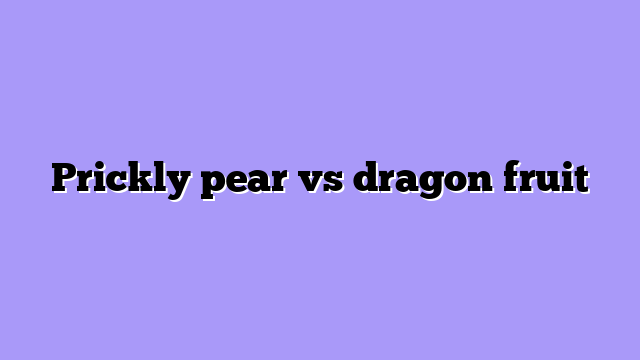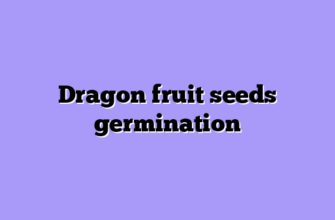Prickly pear and dragon fruit are two of the most popular exotic fruits in the world. Both fruits have a unique flavor and texture, and are packed with essential vitamins and minerals. While they may look similar, there are some key differences between the two. Prickly pear is a type of cactus fruit that is native to Mexico and the southwestern United States. It has a sweet, juicy flesh and a mild flavor.
Dragon fruit, on the other hand, is a tropical fruit native to Central and South America. It has a sweet, slightly tart flavor and a crunchy texture. Both fruits are high in fiber, vitamins, and minerals, and can be eaten fresh or used in a variety of recipes.
Exploring the World of Prickly Pear vs. Dragon Fruit: A First-Person Perspective
As a food enthusiast always on the lookout for unique flavors and culinary experiences, I recently found myself intrigued by the prickly pear and dragon fruit. These exotic fruits have been gaining popularity not just for their vibrant appearance but also for their distinct tastes and potential health benefits. Eager to delve deeper into the realm of these tropical wonders, I embarked on a journey to compare and contrast prickly pears and dragon fruits firsthand. Here’s a step-by-step guide to my exploration:
- Research and Preparation: Before diving into tasting these fruits, I decided to educate myself about their origins, nutritional profiles, and culinary uses. Prickly pears, also known as cactus pears, are native to the Americas and come from the prickly pear cactus. They are rich in antioxidants, vitamins, and minerals, with a subtly sweet flavor reminiscent of watermelon or kiwi. On the other hand, dragon fruits, originating from the cactus species Hylocereus, are native to Mexico and Central America. They are packed with vitamin C, fiber, and beneficial antioxidants, offering a mildly sweet taste reminiscent of a blend of pear and kiwi.
- Procurement: Armed with knowledge about these intriguing fruits, I set out to find fresh specimens. Fortunately, I found both prickly pears and dragon fruits at a local specialty grocery store. The prickly pears were vibrant in color, with their signature spiky exterior, while the dragon fruits stood out with their striking pink or yellow skin and green scales.
- Examination: Before tasting, I carefully examined each fruit, noting their appearance, texture, and aroma. The prickly pear’s skin was tough and covered in fine spines, requiring caution when handling. However, beneath its prickly exterior, the flesh was soft and juicy, ranging in color from pale yellow to deep magenta. In contrast, the dragon fruit’s skin was smooth and leathery, with vibrant hues of pink or yellow. Slicing it open revealed a white or pink flesh speckled with tiny black seeds, resembling a cross between a kiwi and a pear.
- Tasting: With both fruits ready for sampling, I proceeded with anticipation. Starting with the prickly pear, I carefully peeled away the skin to reveal the succulent flesh inside. The taste was refreshing, with a delicate sweetness reminiscent of a blend of watermelon and pear, tinged with subtle floral notes. The texture was soft and slightly grainy, similar to that of a ripe kiwi. Moving on to the dragon fruit, I scooped out a spoonful of its flesh, marveling at its vibrant color and speckled appearance. The flavor was milder compared to the prickly pear, with a subtle sweetness akin to a mix of pear and kiwi, complemented by a slight tartness. The texture was smooth, with the crunch of the tiny seeds adding a delightful contrast.
- Reflection: After tasting both fruits side by side, I reflected on their unique characteristics and culinary potential. While prickly pears offered a more pronounced sweetness and floral aroma, dragon fruits impressed with their striking appearance and mild, refreshing flavor. Both fruits showcased versatility in various culinary applications, from smoothies and salads to desserts and cocktails. Additionally, their abundance of nutrients and antioxidants made them valuable additions to a healthy diet.
In conclusion, my firsthand exploration of prickly pears and dragon fruits revealed not only their distinct flavors and textures but also their potential to elevate culinary experiences. Whether enjoyed on their own or incorporated into creative recipes, these exotic fruits continue to captivate taste buds and inspire culinary adventures.
Exploring the Nutritional Benefits
Prickly pear and dragon fruit are two exotic fruits that are gaining popularity in the health food industry. Both fruits are packed with essential vitamins and minerals, making them a great addition to any diet. In this article, we will explore the nutritional benefits of prickly pear and dragon fruit to help you decide which one is best for you.
Prickly pear is a type of cactus fruit that is native to Mexico and the southwestern United States. It is a rich source of dietary fiber, vitamin C, and potassium. It also contains a variety of antioxidants, including flavonoids and polyphenols, which can help protect against oxidative damage. Prickly pear is also a good source of magnesium, which is important for bone health and muscle function.
Dragon fruit is a good source of dietary fiber, vitamin C, and potassium. It also contains a variety of antioxidants, including carotenoids and polyphenols, which can help protect against oxidative damage. Dragon fruit is also a good source of magnesium, which is important for bone health and muscle function.

When it comes to nutritional benefits, both prickly pear and dragon fruit offer a variety of vitamins and minerals. However, prickly pear has a higher concentration of dietary fiber, vitamin C, and potassium than dragon fruit. Additionally, prickly pear contains more antioxidants than dragon fruit, making it a better choice for those looking to increase their antioxidant intake.
Ultimately, both prickly pear and dragon fruit are excellent sources of essential vitamins and minerals. However, prickly pear has a higher concentration of dietary fiber, vitamin C, and potassium, as well as more antioxidants, making it the better choice for those looking to increase their nutrient intake.
Comparing the Taste and Texture
The prickly pear and dragon fruit are two exotic fruits that are gaining popularity in the United States. While they may look similar, they have distinct differences in taste and texture.
The prickly pear is a type of cactus fruit that has a sweet and tart flavor. It has a soft, juicy texture with small edible seeds. The flesh of the fruit is usually yellow or pink in color.
Dragon fruit, on the other hand, has a mild, sweet flavor. It has a crunchy texture with a slightly chewy center. The flesh of the fruit is usually white or pink in color.
When it comes to taste, the prickly pear is sweeter than the dragon fruit. The dragon fruit has a milder flavor that is slightly sweet.
In terms of texture, the prickly pear is softer and juicier than the dragon fruit. The dragon fruit has a crunchy texture with a slightly chewy center.
Overall, the prickly pear and dragon fruit are two unique fruits that have distinct differences in taste and texture. While the prickly pear is sweeter and softer, the dragon fruit has a milder flavor and a crunchy texture.
Exploring the Different Uses
Prickly pear and dragon fruit are two unique and visually striking fruits that are gaining popularity in the culinary world. While they may look similar, they have distinct differences in flavor, texture, and uses.
Prickly pear, also known as cactus fruit, is a type of cactus native to Mexico and the southwestern United States. It has a sweet, mild flavor and a soft, juicy texture. The flesh of the fruit is typically eaten raw, but it can also be used in jams, jellies, and sauces. Prickly pear is also a popular ingredient in margaritas and other cocktails.
Dragon fruit has a sweet, slightly tart flavor and a crunchy texture. The flesh of the fruit is typically eaten raw, but it can also be used in smoothies, juices, and desserts. Dragon fruit is also a popular ingredient in salads and salsas.
Both prickly pear and dragon fruit are high in fiber, vitamins, and minerals. They are both low in calories and fat, making them a healthy addition to any diet. Prickly pear is also high in antioxidants, which can help protect against disease and aging.
In conclusion, prickly pear and dragon fruit are two unique and visually striking fruits that have distinct differences in flavor, texture, and uses. While both are high in fiber, vitamins, and minerals, prickly pear is also high in antioxidants. Both fruits can be used in a variety of dishes, from jams and jellies to smoothies and salads.
Examining the Health Benefits
The prickly pear and dragon fruit are two exotic fruits that have recently become popular for their health benefits. While both fruits are packed with essential vitamins and minerals, they differ in their nutritional content and potential health benefits. This article will examine the health benefits of prickly pear and dragon fruit in order to help readers make an informed decision about which fruit to include in their diet.
Prickly pear, also known as cactus fruit, is a type of cactus native to Mexico and the southwestern United States. It is a rich source of dietary fiber, vitamins A, C, and K, and minerals such as magnesium, calcium, and potassium. Prickly pear is also a good source of antioxidants, which can help protect the body from free radical damage. Studies have shown that prickly pear can help reduce inflammation, lower cholesterol, and improve blood sugar levels. Additionally, it may help reduce the risk of certain types of cancer and improve digestive health.

Dragon fruit, also known as pitaya, is a tropical fruit native to Central and South America. It is a good source of dietary fiber, vitamins C and B, and minerals such as magnesium, calcium, and potassium. Dragon fruit is also a good source of antioxidants, which can help protect the body from free radical damage. Studies have shown that dragon fruit can help reduce inflammation, improve blood sugar levels, and reduce the risk of certain types of cancer. Additionally, it may help improve digestive health and boost the immune system.
In conclusion, both prickly pear and dragon fruit are excellent sources of essential vitamins and minerals and can provide numerous health benefits. While both fruits are packed with antioxidants and can help reduce inflammation and improve blood sugar levels, they differ in their nutritional content and potential health benefits. Therefore, it is important to consider both fruits when deciding which one to include in your diet.
Investigating the Cultivation and Harvesting
Prickly pear and dragon fruit are two unique and delicious fruits that are cultivated and harvested in many parts of the world. While they may look similar, they have distinct differences in their cultivation and harvesting processes.
Prickly pear is a type of cactus that is native to Mexico and the southwestern United States. It is a low-growing plant that can reach up to three feet in height and has flat, oval-shaped pads that are covered in small spines. The fruit of the prickly pear is a bright red or yellow berry that is sweet and juicy.
Prickly pear is typically grown in dry, arid climates and requires little water or maintenance. The plants are propagated by cutting off a pad and planting it in the ground. The plants will begin to produce fruit after two to three years. When the fruit is ripe, it can be harvested by hand or with a tool such as a knife or pruning shears.
Dragonfruit is a climbing vine that produces large, bright pink or yellow flowers. The fruit of the dragon fruit is a bright pink or yellow berry with a white, sweet flesh.
Dragon fruit is typically grown in tropical climates and requires more water and maintenance than prickly pear. The plants are propagated by cutting off a stem and planting it in the ground. The plants will begin to produce fruit after one to two years. When the fruit is ripe, it can be harvested by hand or with a tool such as a knife or pruning shears.
Both prickly pear and dragon fruit are delicious fruits that can be enjoyed fresh or used in a variety of recipes. While they have similar cultivation and harvesting processes, they have distinct differences that make them unique.
Conclusion
In conclusion, prickly pear and dragon fruit are both delicious and nutritious fruits that offer a variety of health benefits. While both fruits are high in fiber, vitamins, and minerals, prickly pear is higher in fiber and calcium, while dragon fruit is higher in vitamin C and iron. Both fruits are also low in calories and can be enjoyed in a variety of ways. Ultimately, the choice between prickly pear and dragon fruit comes down to personal preference.








